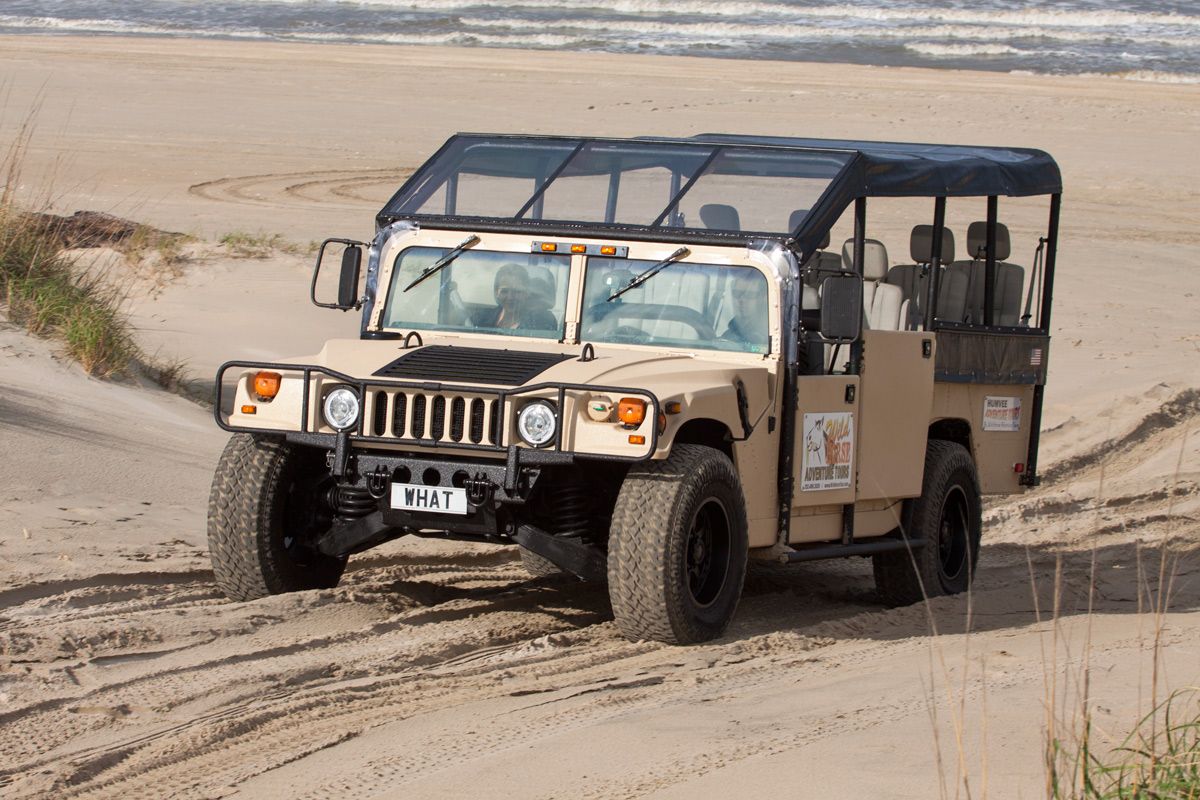The Wild Horses of the Outer Banks
Location: Outer Banks, NC
“Hold on to your hat,” the tour driver said with a laugh.
He wasn’t kidding. Hats take flight during the excursion and are part of the experience. Even with good-natured warning, all 13 of us in the oversized Hummer were giddy with anticipation. Sitting in the back row proved to be a bit of a roller-coaster “high,” but the ride was worth every jubilant minute.
We rolled down Highway 12 to see the wild, Colonial Spanish Mustangs of Corolla (pronounced Kah-rawl-ah), on the way to the sandy beaches of North Carolina’s Outer Banks. It is nature at its best with a history lesson thrown in—the horses date back to the 1500s, when Spanish explorers introduced them to the region.
In season, the native, wild horses are a major draw for tourists. They are also a beloved part of everyday life for locals, who are accustomed to seeing them on the northern beaches of Corolla and smaller community beaches of Swan and Carova (Carolina and Virginia).

The tiny Outer Banks town of Corolla grows from 1,000 residents to nearly 60,000 people in the heaviest tourism months, which occur May through October. Aside from the beaches, the horses are the main attraction. The Corolla herd is one of two wild Colonial Spanish Mustang herds left in the world; mustangs in the other herd are called Shackleford ponies and live in Shackleford Banks, which is also located in the Outer Banks.
The best way to see the horses is with Wild Horse Adventure Tours (WHAT). The two-hour tour is a once-in-a-lifetime experience connecting people with horses and landscape, albeit from a safe distance. A strict local ordinance protects the horses and prohibits tourists from getting closer than 50 feet. During peak season, nearly 50,000 visitors take the WHAT tour; 25 tours are given each day.
Highly trained WHAT tour guides are schooled in history and knowledgeable about the terrain, environment and horses. WHAT training is intense, and guides must pass a comprehensive test before getting behind the wheel of custom-made Hummers with open-air “windows.” WHAT refurbished eight H1 Hummers for the tours. Using Hummers was the idea of Richard Brown, a WHAT owner and self-taught mechanic; he knew only 4×4 vehicles can maneuver sand and thought Hummers would be perfect for the beach tours.

It did not take long before we spotted harems of mustangs on the beach. Unfazed by vehicles that are a part of everyday life, the majestic horses gathered at the water’s edge. It was a perfect moment, and the scene resembled a painting with a background the color of a Carolina sky.
The Corolla herd is made up of approximately 100 horses that live in Corova—the oldest community in the North Corolla beach area—and Swan and North Swan beaches. Herd numbers fluctuate slightly, and six foals were born in 2019.
Our entertaining guide drove us into hidden alcoves with “neighborhoods” where we could observe wild horses in nature. Off the main beach, houses mix with terrain; pine trees and wood-like foliage resemble Old Florida. At times, horses took breaks from the beach to relax and eat in the shade. Mustangs are smaller in stature than most horses; the guide explained they are typically 13-14 hands high. He told us that nearby homeowners also had to follow the same restrictions and stay 50 feet away from the horses.
The respect that WHAT has for the horses is equally matched by another organization’s respect: The Corolla Wild Horse Fund (CWHF). The nonprofit’s mission is to protect the horses, preserve their environment and educate the public. By way of aerial view, helicopters keep close tabs on herd numbers throughout the year. The count is critical; dwindling numbers have put the horses on an endangered list. In the 1920s, the horses numbered around 6,000, but time and mankind have taken a toll.
A herd manager and staff monitor the health and behavior of horses on a daily basis. They also study herd interactions. Horses are free to live naturally off the land for food and water. Contraception is used on mares more than 10 years old to protect horse and herd health and lessen birth defects.
A mustang’s wild diets consists of sea oats, grasses, acorns, persimmons, an invasive plant (phragmite) and milfoil, a sub-aquatic plant that grows in manmade canals. They do not receive supplemental feeding but are closely monitored throughout winter months. Water sources include the Currituck Sound, a freshwater estuarine system.

CWHF Director Jo Langone said the distance requirement keeps horses and people safe.
“An exception is made when a horse is too ill to recover from an injury or sickness without medical intervention, or if a horse becomes too relaxed around people,” Langone explained.
In these instances, CWHF permanently relocates compromised horses to its 30-acre rescue facility for rehabilitation. The facility treats horses with critical illnesses, life-threatening injuries or habituation issues. The relocation is permanent because reintroducing a rehabilitated horse to the wild herd could result in the transfer of domestic diseases. It would also be challenging for these horses to adjust back to life in the wild.
Langone acknowledges that wild horses of Corolla are self-sufficient and hardy, as they have been for centuries. However, in September 2019, Hurricane Dorian struck near Cedar Island and 28 horses died, diminishing the herd of 49 by half.
“Horses have natural instincts to protect themselves, but in the case of Dorian, it happened too fast,” said Langone. “The water surged to eight feet within an hour and the horses had no time to escape.”
The tragedy hit the equine community hard, but fortunately the animals are resilient. New foals are born, and herds continue to thrive thanks to WHAT and CWHF. Both organizations are dedicated to educating the public and preserving an important 500-year legacy. A beach with wild horses—what could possibly be better?
– Originally published in The Virginia Sportsman. Reused for educational purposes.